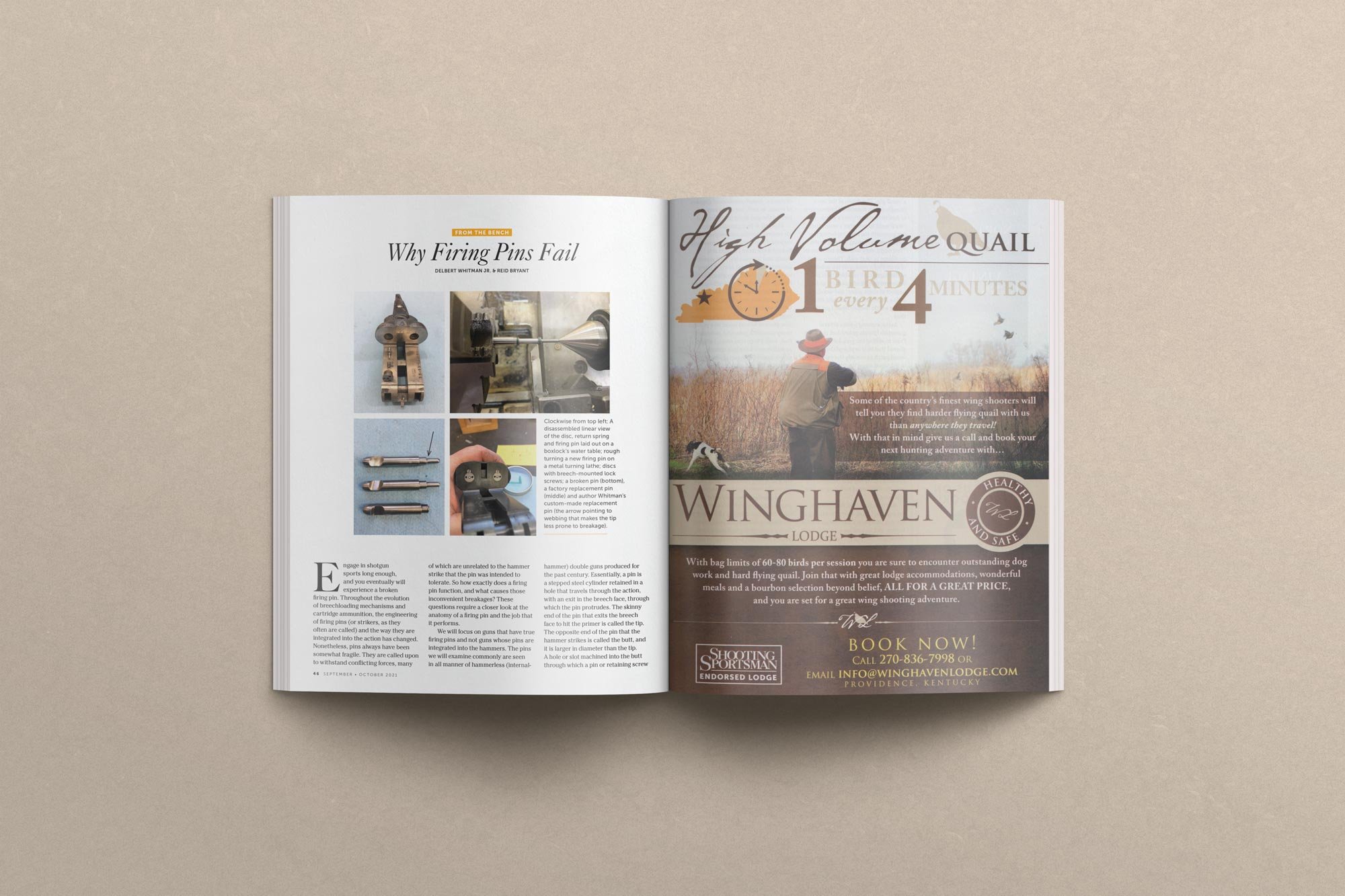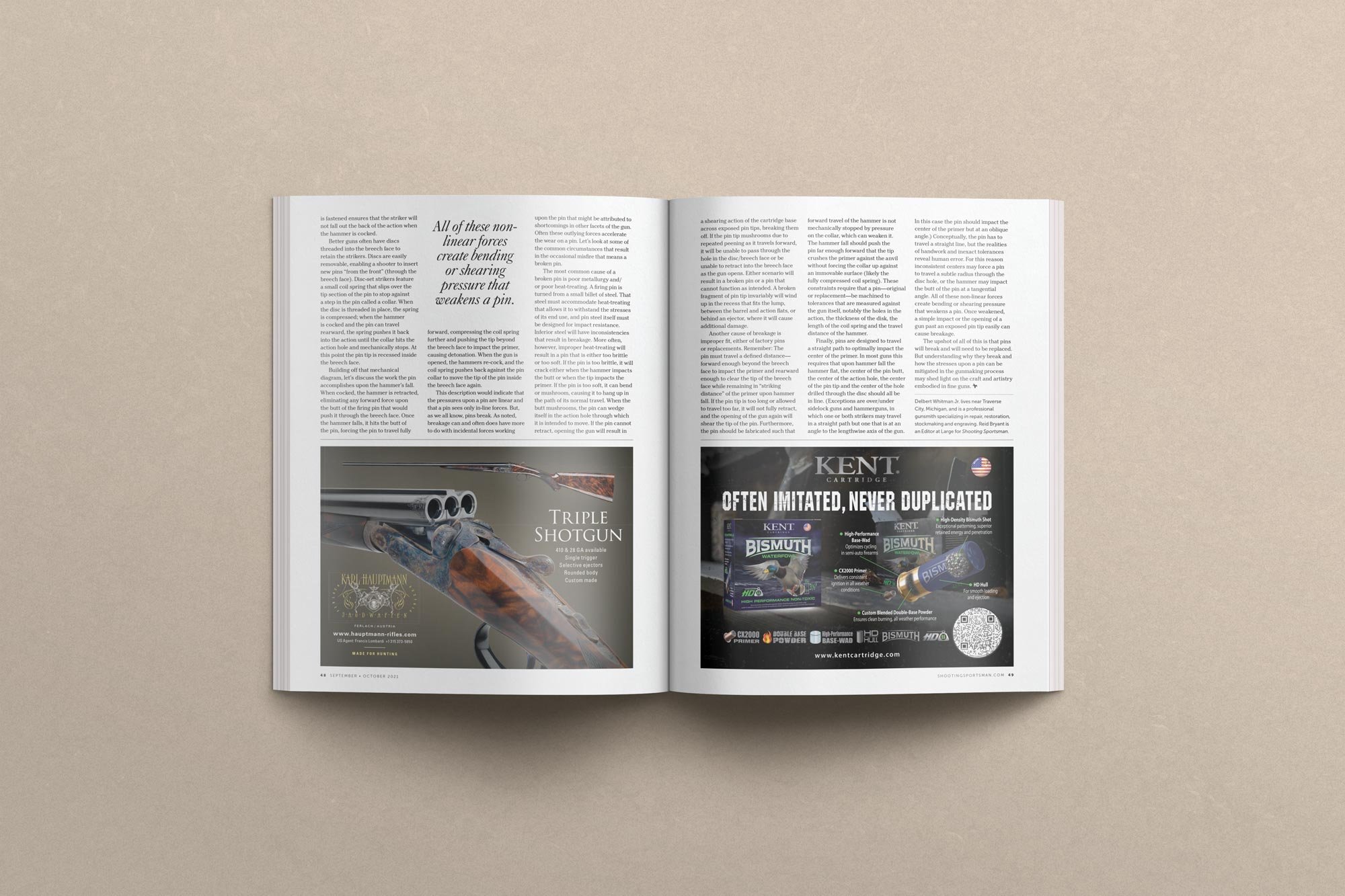Why Firing Pins Fail
Engage in shotgun sports long enough, and you eventually will experience a broken firing pin. Throughout the evolution of breechloading mechanisms and cartridge ammunition, the engineering of firing pins (or strikers, as they often are called) and the way they are integrated into the action has changed. Nonetheless, pins always have been somewhat fragile: They are called upon to withstand conflicting forces, many of which are unrelated to the hammer strike that the pin was intended to tolerate. So how exactly does a firing pin function, and what causes those inconvenient breakages? These questions require a closer look at the anatomy of a firing pin and the job that it performs.
We will focus on guns that have true firing pins and not guns whose pins are integrated into the hammers. The pins we will examine commonly are seen in all manner of hammerless (internal-hammer) double guns produced for the past century. Essentially, a pin is a stepped steel cylinder retained in a hole that travels through the action, with an exit in the breech face, through which the pin protrudes. The skinny end of the pin that exits the breech face to hit the primer is called the tip. The opposite end of the pin that the hammer strikes is called the butt, and it is larger in diameter than the tip. A hole or slot machined into the butt through which a pin or retaining screw is fastened ensures that the striker will not fall out the back of the action when the hammer is cocked.
Better guns often have discs threaded into the breech face to retain the strikers. Discs are easily removable, enabling a shooter to insert new pins “from the front” (through the breech face). Disc-set strikers feature a small coil spring that slips over the tip section of the pin to stop against a step in the pin called a collar. When the disc is threaded in place, the spring is compressed; when the hammer is cocked and the pin can travel rearward, the spring pushes it back into the action until the collar hits the action hole and mechanically stops. At this point the pin tip is recessed inside the breech face.
Building off that mechanical diagram, let’s discuss the work the pin accomplishes upon the hammer’s fall. When cocked, the hammer is retracted, eliminating any forward force upon the butt of the firing pin that would push it through the breech face. Once the hammer falls, it hits the butt of the pin, forcing the pin to travel fully forward, compressing the coil spring further and pushing the tip beyond the breech face to impact the primer, causing detonation. When the gun is opened, the hammers re-cock, and the coil spring pushes back against the pin collar to move the tip of the pin inside the breech face again.
This description would indicate that the pressures upon a pin are linear and that a pin sees only in-line forces. But, as we all know, pins break. As noted, breakage can and often does have more to do with incidental forces working upon the pin that might be attributed to shortcomings in other facets of the gun. Often these outlying forces accelerate the wear on a pin. Let’s look at some of the common circumstances that result in the occasional misfire that means a broken pin.
The most common cause of a broken pin is poor metallurgy and/or poor heat-treating. A firing pin is turned from a small billet of steel. That steel must accommodate heat-treating that allows it to withstand the stresses of its end use, and pin steel itself must be designed for impact resistance. Inferior steel will have inconsistencies that result in breakage. More often, however, improper heat-treating will result in a pin that is either too brittle or too soft. If the pin is too brittle, it will crack either when the hammer impacts the butt or when the tip impacts the primer. If the pin is too soft, it can bend or mushroom, causing it to hang up in the path of its normal travel. When the butt mushrooms, the pin can wedge itself in the action hole through which it is intended to move. If the pin cannot retract, opening the gun will result in a shearing action of the cartridge base across exposed pin tips, breaking them off. If the pin tip mushrooms due to repeated peening as it travels forward, it will be unable to pass through the hole in the disc/breech face or be unable to retract into the breech face as the gun opens. Either scenario will result in a broken pin or a pin that cannot function as intended. A broken fragment of pin tip invariably will wind up in the recess that fits the lump, between the barrel and action flats, or behind an ejector, where it will cause additional damage.
Another cause of breakage is improper fit, either of factory pins or replacements. Remember: The pin must travel a defined distance—forward enough beyond the breech face to impact the primer and rearward enough to clear the tip of the breech face while remaining in “striking distance” of the primer upon hammer fall. If the pin tip is too long or allowed to travel too far, it will not fully retract, and the opening of the gun again will shear the tip of the pin. Furthermore, the pin should be fabricated such that forward travel of the hammer is not mechanically stopped by pressure on the collar, which can weaken it. The hammer fall should push the pin far enough forward that the tip crushes the primer against the anvil without forcing the collar up against an immovable surface (likely the fully compressed coil spring). These constraints require that a pin—original or replacement—be machined to tolerances that are measured against the gun itself, notably the holes in the action, the thickness of the disk, the length of the coil spring and the travel distance of the hammer.
Finally, pins are designed to travel a straight path to optimally impact the center of the primer. In most guns this requires that upon hammer fall the hammer flat, the center of the pin butt, the center of the action hole, the center of the pin tip and the center of the hole drilled through the disc should all be in line. (Exceptions are over/under sidelock guns and hammerguns, in which one or both strikers may travel in a straight path but one that is at an angle to the lengthwise axis of the gun. In this case the pin should impact the center of the primer but at an oblique angle.) Conceptually, the pin has to travel a straight line, but the realities of handwork and inexact tolerances reveal human error. For this reason inconsistent centers may force a pin to travel a subtle radius through the disc hole, or the hammer may impact the butt of the pin at a tangential angle. All of these non-linear forces create bending or shearing pressure that weakens a pin. Once weakened, a simple impact or the opening of a gun past an exposed pin tip easily can cause breakage.
The upshot of all of this is that pins will break and will need to be replaced. But understanding why they break and how the stresses upon a pin can be mitigated in the gunmaking process may shed light on the craft and artistry embodied in fine guns.
First Published in Shooting Sportsman Magazine


